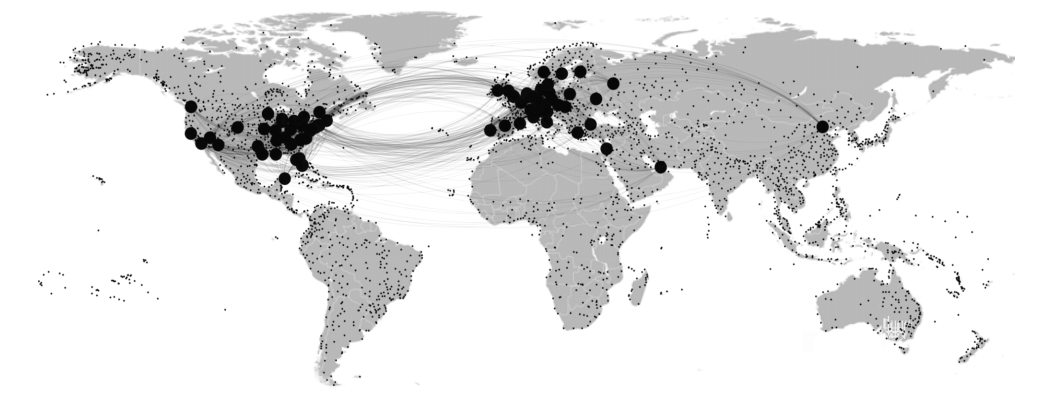In April 2010, an Icelandic volcano called Eyjafjallajökull suddenly erupted, spewing millions of tons of dust and ash into the atmosphere above western and northern Europe. Airborne ash can clog jet engines, so some 20 countries immediately closed their air space to commercial air traffic.

The eruption lead to the cancellation of more than 60 percent of European flights over a period of five days and affected more than 100,000 travelers.
This kind of disruption is unprecedented, but it raises an important question. How vulnerable is the global airline network to disruptions of this kind? And if one part of the network is shut, how does this disruption spread?
Today we get an answer thanks to the work of Trivik Verma at ETH Zurich and a few pals. Their conclusion is unexpected.
They say that the world airline network consists of a core of major airports that is hugely robust. By this, they mean that if one airport is closed there are always other routes to your destination.
But the world airline network also consists of another network of peripheral airports that are hugely vulnerable. Close the hubs that connect to these airports and entire regions of the planet become inaccessible.
These guys began by analyzing the 18,000 routes that exist between 3237 airports all over the planet. In this network, the airports are nodes and a link exists between them if they have a flight connection. The strength of this link is determined by the number of connections.
An ordinary analysis reveals this to be a standard scale free network, like the Internet, that would ordinarily be considered robust. The average path length between two airports is just over four connections and the largest distance between any pair of airports is 12 connections (the authors do not say where these unlucky airports are).
But a closer analysis reveals something else. Verma and co are interested in the vulnerable parts of the world airline network. So having constructed this web, they begin to remove airports that are least well-connected.
The key idea in their analysis is that when a particular route between airport A and airport B is unavailable, there is usually another route via airport C. This kind of triangle formation is a vital part of the connectedness of the system.
To reveal the most vulnerable parts of the network, Verma and co start by taking away those airports that have only one link to another airport—in other words, airports that are not part of any triangles. These form the periphery of the network.
They then take away airports that are connected to only one triangle, then those connected to two triangles, three triangles and so on.
The final airports in this process form the core of the network. They consist of 73 airports that are all connected by almost 400 triangles. These are airports like Frankfurt, Heathrow, Dubai, Chicago, Los Angeles, and so on.
What’s curious about this core is that if all 73 of its airports are removed from the network, 90 percent of the other airports are still interconnected. That appears to show a remarkable degree of robustness.
But there are other important hubs that have many connections but are actually fragile because they link to other airports that are not part of any triangles. These hubs are at the centers of star-like structures at the periphery of the network. When these are removed, all these peripheral airports are disconnected and that part of the world becomes inaccessible.
An example is St Petersburg airport in Tampa Bay, Florida. This has 24 connections and only 24 flights. Close this airport and the airports it connects to are all cut out of the global network.
That makes the world airline network rather unusual. “It is surprising, insofar as there exists a highly resilient and strongly connected core consisting of a small fraction of airports together with an extremely fragile star-like periphery,” say Verma and co.
How could such a network have arisen? Verma and co think one possible reason is the tension that airline companies experience between the necessity to minimize flying time while also maximizing profit.
The best way to minimize flying time is to have a fully connected network in which every pair of airports has a direct connection. But this is only economically viable in parts the world that are densely populated or have intensive economic activity. “The scanty number of passengers traveling to and from remote regions only justifies the creation of a star-like network,” they say.
That’s an interesting conclusion that airlines could use to help maximize their profit while redesigning the network to make it more resilient.
In the meantime, if you live close to one of the world’s peripheral airports, you’ll just have to hope that there isn’t a volcanic eruption nearby.
Ref: arxiv.org/abs/1404.1368 : Revealing the Structure of the World Airline Network
Keep Reading
Most Popular
Large language models can do jaw-dropping things. But nobody knows exactly why.
And that's a problem. Figuring it out is one of the biggest scientific puzzles of our time and a crucial step towards controlling more powerful future models.
How scientists traced a mysterious covid case back to six toilets
When wastewater surveillance turns into a hunt for a single infected individual, the ethics get tricky.
The problem with plug-in hybrids? Their drivers.
Plug-in hybrids are often sold as a transition to EVs, but new data from Europe shows we’re still underestimating the emissions they produce.
Google DeepMind’s new generative model makes Super Mario–like games from scratch
Genie learns how to control games by watching hours and hours of video. It could help train next-gen robots too.
Stay connected
Get the latest updates from
MIT Technology Review
Discover special offers, top stories, upcoming events, and more.